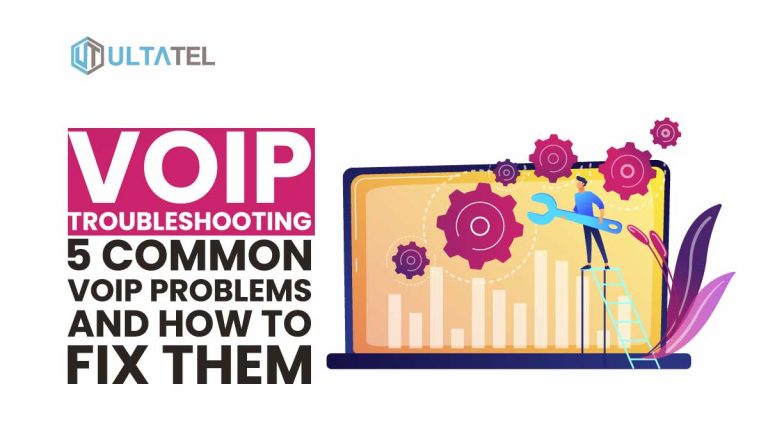Experiencing technical issues with your VoIP phone can be an aggravating experience, particularly when you’re required to wait for extended periods to speak with a customer representative. Every agent must possess basic troubleshooting knowledge when confronted with such situations. By troubleshooting the issue first, you can minimize the chances of customers experiencing additional problems. In this article, we’ll dive into the five most fundamental issues that can arise with any cloud phone system.
Troubleshooting Common VoIP Issues
In case you encounter difficulties with VoIP, it is likely caused by problems with your networking, internet connectivity, security, or related device issues. In order to resolve these possible issues, it is recommended to follow the troubleshooting steps in a sequential manner and eliminate each potential problem until the underlying cause is identified.
Some of the problems you might face are:
1. Network & LAN Issues
If you’re experiencing difficulties with your internet-connected devices, it’s possible that the problem lies with your LAN, or Networking and Local Area Network. This commonly occurs when your router malfunctions or is incompatible with cloud telephony. In order to ensure that your Voice over Internet Protocol (VoIP) calls remain of high quality, it’s essential to have a router equipped with Quality of Service (QoS) capabilities. This enables the prioritization of voice traffic over other network traffic. While the majority of modern broadband routers provide this feature, it’s crucial to configure it correctly to prevent any disruptions to the call quality.
When assessing the situation, consider these four tricks before purchasing an entirely new device:
- To troubleshoot connectivity issues with your router, try unplugging its power cord for 30 seconds and plugging it back in. This is a quick reset that can often solve the problem.
- Ensure that your router is set up with Quality of Service (QoS) settings for VoIP. Check your router’s compatibility and confirm that the settings are enabled.
- Disable SIP ALG (Application Layer Gateway) or forward ports. The quick fix is just turn your SIP ALG off and disable “SIP Helpers” within your router.
- Upgrading to a newer version of the firmware may be the easiest solution to your problems.
2. Phone & Voice Quality
If you’re having problems with your phone and voice quality, it’s important to check if the call volume is low, if there is any interference, or if your phone equipment is faulty.
There are four things to watch out for when checking the phone and voice quality of your device:
- Try covering your phone’s mouthpiece; if it echos, buzzes, or there’s some interference, you may need to turn down the volume.
- Attempt moving your router to a new location around your space. Always keep the router from your computer monitors, fans, and power strips. Something might be causing that interference because it’s too close.
- Check your equipment for bypassing splitters or caller ID devices. Remove third-party equipment and connect the router directly. The equipment may be faulty and will not provide you with the assistance you need to fix the issue.
- Check your equipment carefully. Outdated equipment can lead to bad voice quality, so upgrading may be needed.
3. WAN & Internet Connectivity
It is important to ensure that your internet package is specifically designed for business use and has the capability to support VoIP if you are experiencing connectivity issues with your WAN or internet connection. It’s worth noting that certain internet packages may not offer the necessary power to enable seamless VoIP usage, so it’s important to check that your package meets these requirements.
Here is how to check if your WAN connectivity and internet speed is up to VoIP standards:
- Set up a bandwidth speed test. When setting up a speed test, plug in your device directly to the modem to get the most accurate reading.
- Test for packet loss. It is important to perform a ping test to check for any packet loss, even a small amount, as it can lead to troubleshooting issues.
- Contact your ISP. Check your LAN first to see if the problem is there. If it’s your WAN, contact your ISP for help. There may be an outage or other internet issues in your area.
4. Security
It’s important to be aware that VoIP can be vulnerable to virtual attacks and security threats due to its direct connection to the internet. These security concerns not only impact call quality but also put customer data at risk of being exposed. In the event that you encounter any troubleshooting related to these issues, it’s crucial to take swift action.
Here are three steps to take when encountering security issues:
- Reset all of your passwords. Protect your VoIP credentials from hackers by using a strong, complex password and resetting it regularly. Use a combination of capital and lowercase letters, symbols, and numbers for increased security.
- Identity problem-causing devices. To ensure safety during your calls, consider using firewalls to regulate the type of traffic allowed. Firewall maps can detect unusual patterns and alert you of potential attacks.
- Implement VLAN tagging for your devices.
5. Faxing Issues & Other Devices
In our modern-day society, numerous organizations are dependent on digital documentation. Nonetheless, the utilization of fax machines, scanners, and printers still proves to be more dependable when it comes to receiving data. Regrettably, fax machines are not compatible with VoIP, which can lead to certain problems.
Here are two ways you can solve combat issues due to third-party equipment:
- Install compatible components. In order to guarantee seamless communication between your Voice over Internet Protocol (VoIP) equipment and fax machines, it is necessary to establish a connection between the two. It should be noted that equipment options may vary depending on your service provider, and some may offer a fax bridge that enables the transmission of digital information.
- Find a cohesive security question. You must make sure that your internet connection is compatible with your VoIP phone service because if it’s not then it will cause issues with the security system and your VoIP service.
Tips to Prevent These VoIP Issues from Reoccurring
To avoid experiencing VoIP issues in the future, be sure to adhere to the following three recommendations.
You can segment your VLAN (Virtual Local Area Network)
For optimal performance, it’s important to segment your VoIP phones onto a separate VLAN. This will improve call quality, enhance security, and allow for early problem identification and resolution.
How to optimize your ping and jitter
When using VoIP, your internet connection plays a crucial role. Unfortunately, latency issues such as jitter cannot be entirely avoided. Jitter can negatively impact the quality of voice communication, resulting in robotic-sounding voices. To measure the time it takes for a network to send and receive data packets, you can perform ping tests. You can customize these tests to “ping” when connecting to another device.
Use Ethernet over Wi-Fi
When it comes to connecting to the internet, it’s worth considering the pros and cons of different methods. While Wi-Fi is convenient and widely available, its performance can be hampered by a variety of factors. Radio signals can interfere with the connection, leading to slower speeds and more dropped calls. On the other hand, Ethernet cables provide a more stable and secure connection, with speeds that can far exceed those of Wi-Fi. If you’re looking for a fast and reliable way to access the internet, Ethernet is definitely worth considering.
Summary
If you’re using VoIP, it’s possible that you may run into some issues. But don’t worry! This list of five common VoIP problems and their solutions will help you out. There are many benefits to switching from traditional landline calls to VoIP, and if you do experience any difficulties, these quick tips may be able to help you resolve them on your own. Of course, if you need further assistance, don’t hesitate to contact your provider.

